CIGRE Technical Evolution 2009-2019
CIGRE has often emphasized, in Electra and elsewhere, the importance of the transition towards a sustainable and ultimately climate-neutral energy system, and of the key role the end-to-end power system plays for this transition. This also means that CIGRE’s work must and does evolve substantially. This Technical Council paper documents how the Study Committees have indeed evolved the contents and scope of their work in a flexible, dynamic and forward-looking way, to ensure CIGRE meets the world’s growing need for the creation and sharing of power system expertise and as a E2E – End-to-End organization.

by Marcio Szechtman, CIGRE Technical Council Chair & Yves Maugain, Technical Council Secretary
This paper was prepared with the significant contributions from the 16 Study Committee Chairs.
We have asked all Study Committee (SC) Chairs to present in an easy-to-read graphical form, the main changes in each Committee in the last 10 years (2009-2019).
The following 16 SC graphs show the SCs’ evolution through the number and weighted percentage of strategic technical directions (SD) addressed by active Working Groups (WG). The numbers of WGs on a technical direction is related to the effort to produce Technical Brochures, Preferential Subjects at conferences, Tutorials, Session papers, newsletter articles etc. The evolution of the number of WGs on strategic technical directions that existed already in 2009, and the closing of prior and opening of new technical directions, show how CIGRE’s technical work dynamically follows and often leads the changes in and challenges for the global power systems.
In another article to be published soon we will describe the collective vision of our 16 SCs on the future power system, summarizing the Green Book on the Electricity Supply Systems of the Future.
The following sections describe the evolution observed in the 16 SC of CIGRE in the last 10 years.
As a general trend, we see an increase in the number of active WGs for most SCs, which represents the growth of CIGRE and the growing importance and complexity of the power system for the energy transition. Also, the evolution of the WGs addressing different technical strategic directions shows the influence of the three megatrend-D’s (Digitalization, Decarbonization, Decentralization).
List of abbreviations
- AC: Alternating Current
- DC: Direct Current
- VSC: Voltage Sourced Converters
- HVDC: High Voltage Direct Current
- PE: Power Electronics
- LCC: Line Commutated Converters
- FACTS: Flexible AC Systems
- MV: Medium Voltage
- PMU: Phasor Monitoring Units
- WAMS: Wide Area Measurement System
- EMC: Electromagnetic Compatibility
- EMI: Electromagnetic Interference
- GIS: Gas Insulated Systems
- EPU: Electric Power Utilities
- DER: Distributed Energy Resources
Study Committees A
SC A1 - Rotating electrical machines
The main Strategic Technical Directions (SD) of the SC A1 have been kept in the last decade as follows:
- SD 1: Asset Management
- SD 2: Machine/System Interaction
- SD 3: Renewable Generation
- SD 4: Motors
- SD 5: Machine Monitoring, Diagnosis and Prognosis
- SD 6: Efficiency of Electrical Machines
The Effort allocation among these various SDs over the period considered is shown in Figure 1.
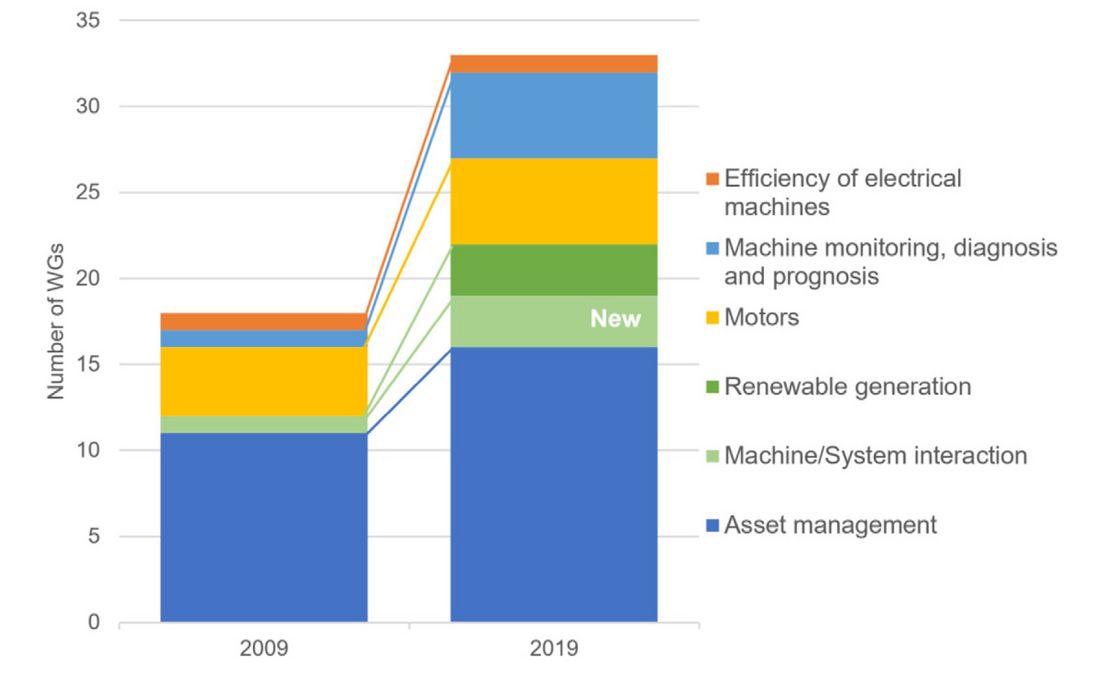
Figure 1 - SC A1 evolution
It is clear the emphasis increase in the directions of Asset Management, Renewable Generation and Monitoring.
SC A2 - Power transformers and reactors
The main Strategic Technical Directions (SD) of the SC A2 have been kept in the last decade as follows:
- SD 1: Specification, Procurement & Economics
- SD 2: Design, Manufacturing & Testing
- SD 3: Diagnostics, Monitoring, Maintenance & Repair
- SD 4: Operation, Reliability, Safety & Environment
The Effort allocation among these various SDs over the period considered is shown in Figure 2.
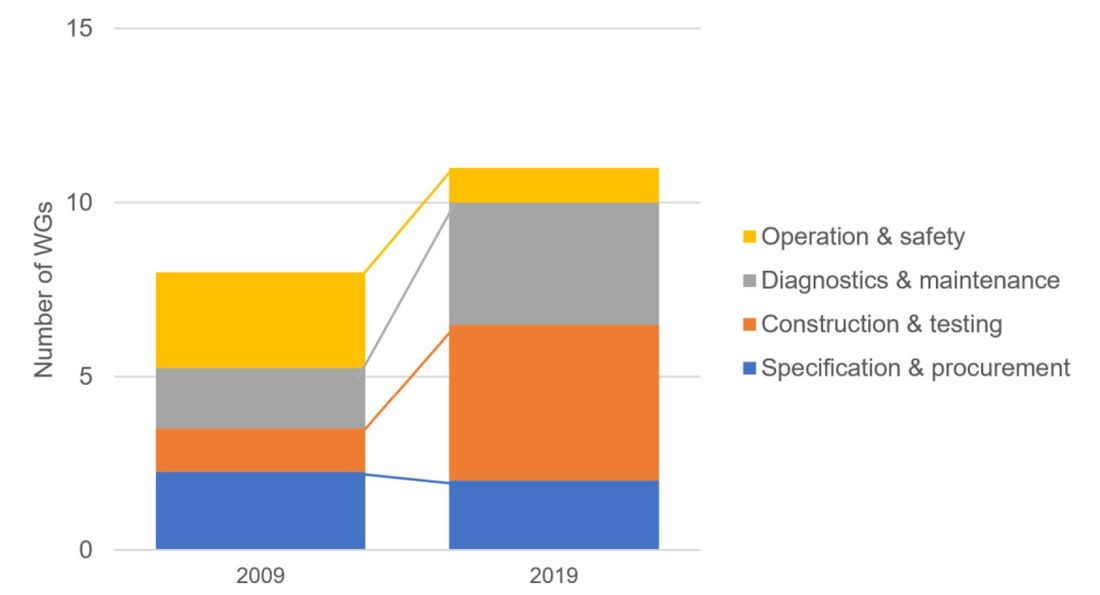
Figure 2 - SC A2 evolution
WGs and JWGs with more than one Strategic Direction have been divided equally between the Strategic Directions concerned. In SC A2, we can see an improvement on SD 2 (Design, Manufacturing & Testing) and SD 3 (Diagnostics, Monitoring, Maintenance & Repair).
SC A3 – Transmission & distribution equipment
In SC A3, we may see a major impact on the incorporation of Distribution and DC Equipment.
Distribution equipment has been incorporated into SD 1, and DC equipment has been included in SD 2 and SD 3.
- SD 1: Lifetime Management T&D Equipment
- SD 2: New Developments and Technologies
- SD 3: Requirements for Changing Networks.
The Effort allocation among these various SDs over the period considered is shown in Figure 3.
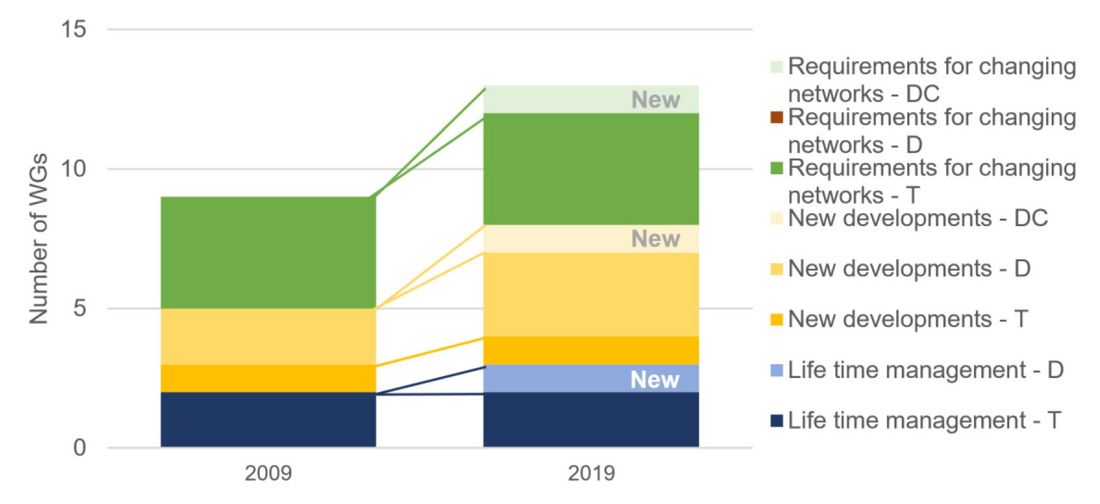
Figure 3 - SC A3 evolution
Study Committees B
SC B1 - Insulated cables
SC B1 presents its SD equally distributed around four phases of cable life:
- SD 1: Design, including system aspects, component aspects, current ratings
- SD 2: Construction, including manufacturing, installation, jointing
- SD 3: Operation, including testing, maintenance, reliability
- SD 4: Life Cycle, including upgrading/uprating, disposal
The SC evolution in past years has been driven by:
- Improvement of core technologies (covering all phases of cable life) and promote quality
- Focus on “Power Systems of the Future” and “Best Use of Existing Systems”
- WGs on Submarine and HVDC Cables increased from 5 (26% of all WGs) in 2009 to 17 (57%) in 2019.
This can be seen in Figure 4. One can also see the increase in the number of active WGs.
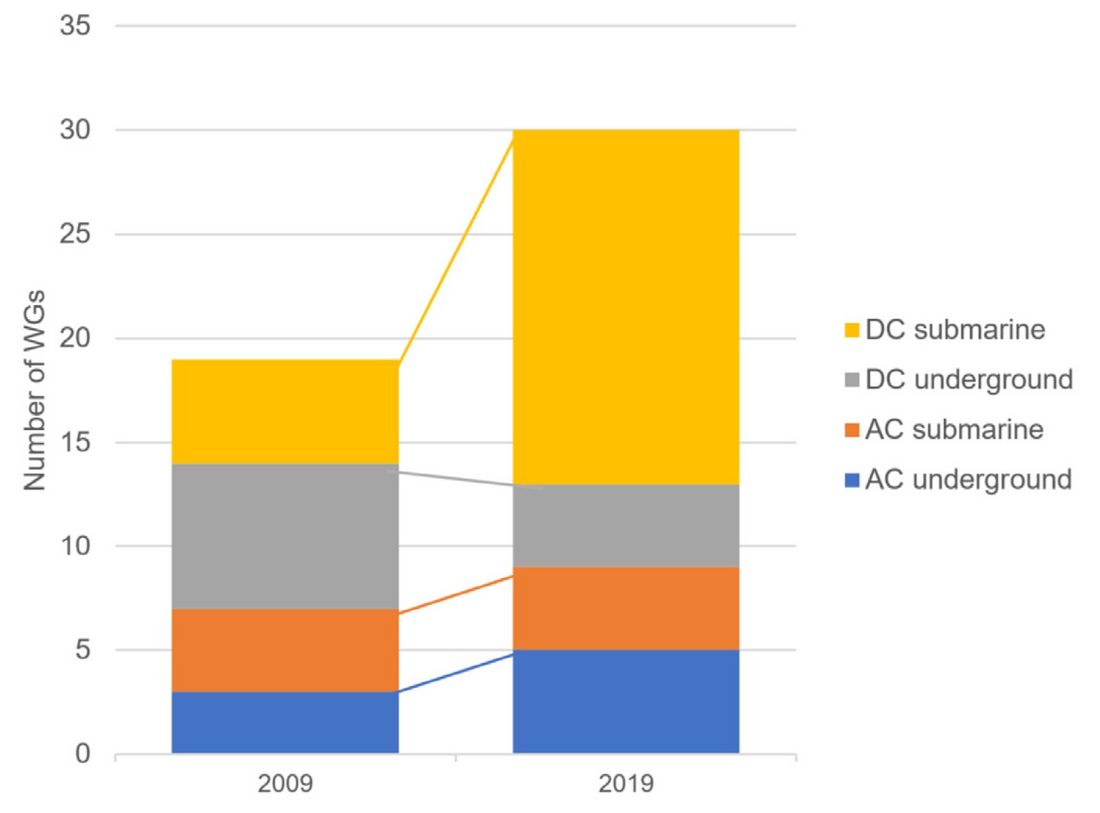
Figure 4 - SC B1 evolution
SC B2 - Overhead lines
SC B2 evolution by SD has been relatively kept constant, as it can be seen in Figure 5.
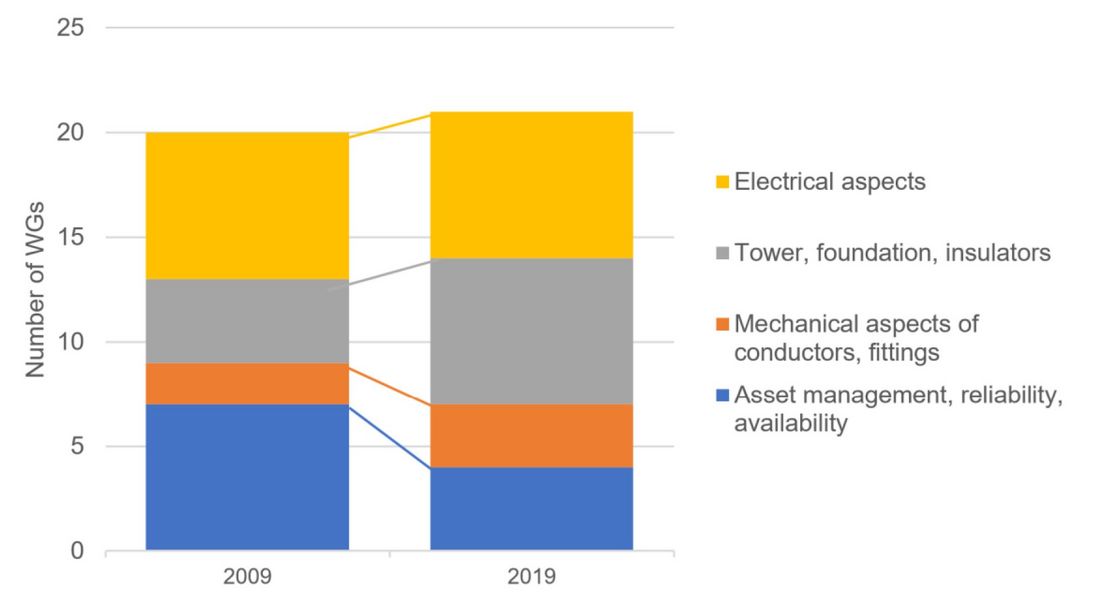
Figure 5 - SC B2 evolution
SC B2 focus increase can be summarized as:
- Increase the ampacity of existing lines
- Ensure reliable lines, or establish / improve the reliability of existing lines, with changes in maintenance methods
- New materials - high temperature conductors, insulators made of composite materials
- Ensure environmentally compatible lines
SC B3 - Substations and electrical installations
SC B3 have adopted the following SD:
- SD 1: New Substation concepts
- SD 2: Substation Ownership Issues
- SD 3: Life Cycle management
- SD 4: Integration of Intelligence for Digitalization on Substation
SC B3 also shows an increase in the number of WGs, with focus on New Substation Concepts and in Integration of Intelligence for Digitalization on Substations as can be seen in Figure 6.
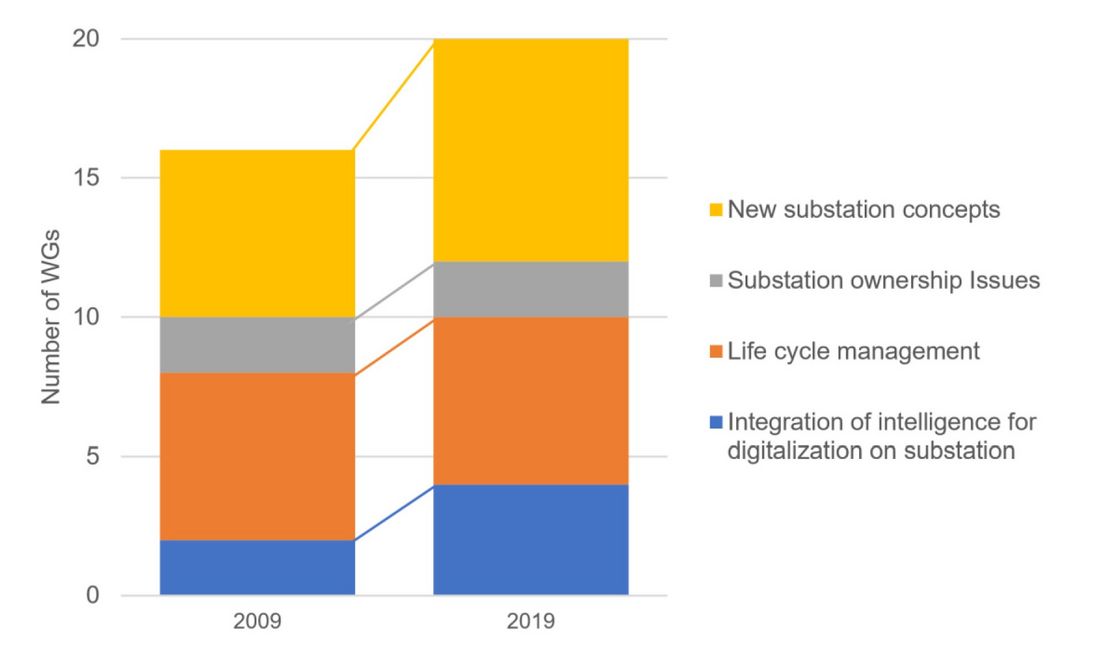
Figure 6 - SC B3 evolution
SC B4 - DC systems and power electronics
Main changes in directions observed within the last 10 years, from 2009 up to 2019 are as follows:
- More application of VSC HVDC
- More feasibility and development on HVDC grids
- More PE applications in other areas with joint effort with other SCs
- Application of DC technologies started to extend to distribution
- Fewer LCC HVDC WGs
- Fewer FACTS WGs
These changes can be seen in Figure 7.
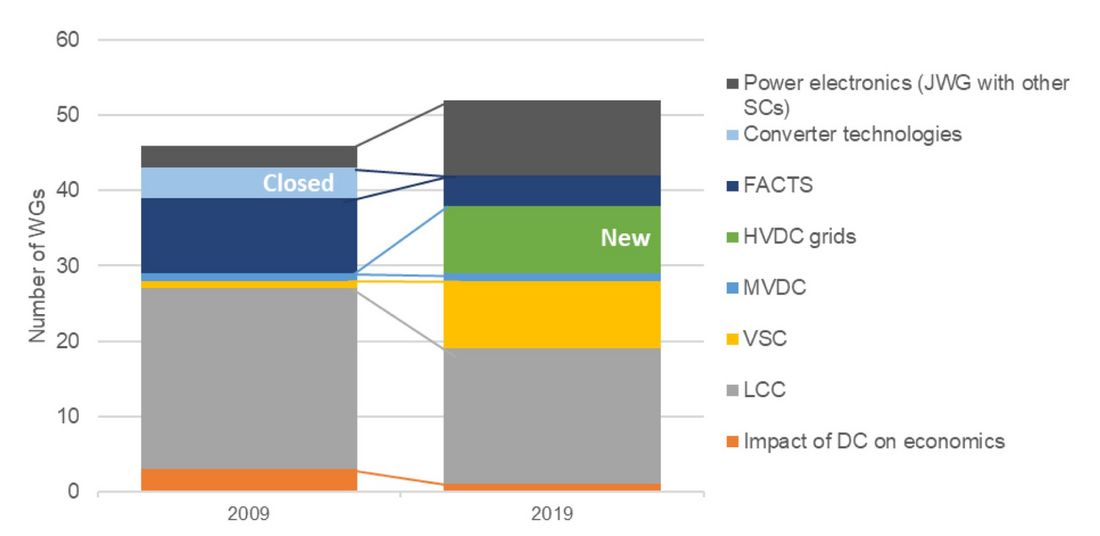
Figure 7 - SC B4 evolution
SC B5 - Protection and automation
The three main technical directions in SC B5 are:
- SD 1: Substation automation
- SD 2: Protection and monitoring
- SD 3: New network requirement
Main changes in directions observed from 2009 to 2019:
The focus of SC B5 is stable but there are some changes towards increased activity on digital substation based on IEC 61850 process bus in addition to Cyber security issues within SD 1.
Investigation to how changes in the power system, like low inertia, affects the protection, monitoring and control is also an important change within SD 2.
There is also a focus towards covering the whole Power system, end-to-end related to this topic, from transmission systems, to distribution systems within SD 3, as it does not make sense in splitting B5 into transmission and distribution as separate entities.
Figure 8 shows these changes and evolution.
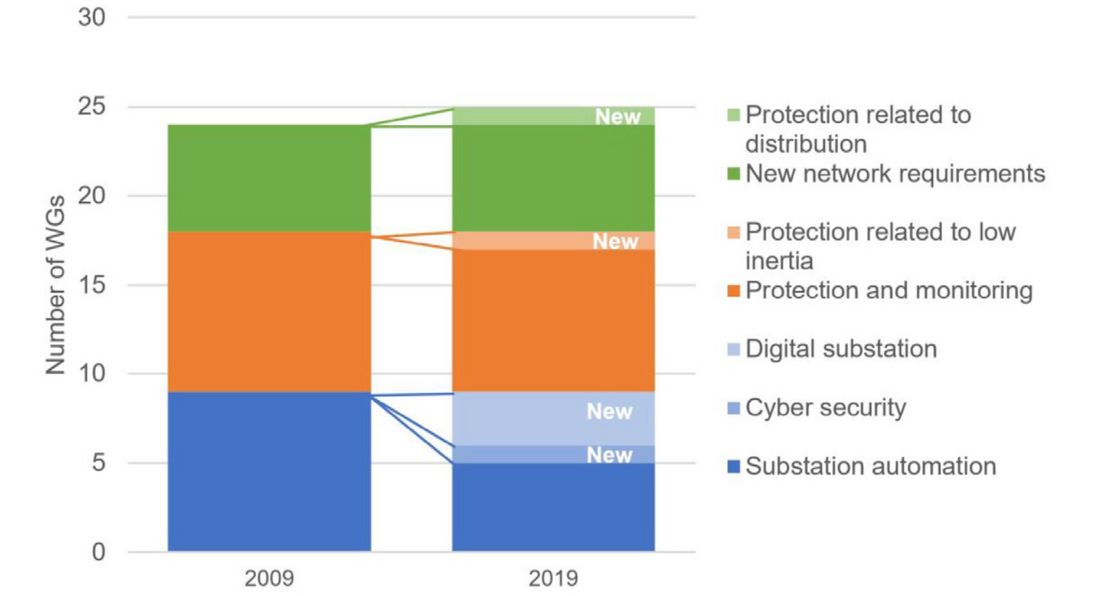
Figure 8 - SC B5 evolution
Study Committees C
SC C1 - Power system development & economics
SC C1 previously had three SD, namely, System Planning, Asset Management and Business Management. Recently a fourth SD on Interconnections – Horizontal and Vertical, has been incorporated to the SC C1 activities.
New aspects related to the energy transition and to digitalization, decarbonization and decentralization, being addressed recently for the four technical directions, are described below:
- SD1: System Planning: Dealing with uncertainties, inter-relationships between transmission and distribution planning; enhancing transmission capacity e.g. by risk-based and other innovative methods.
- SD2: Asset management: Growing inter-relationships between asset management, digitalisation and system planning; value-based asset management and monetization.
- SD3: Business management: Increased non-utility stakeholders’ involvement; changing drivers for investments.
- SD4: Interconnections – horizontal, vertical: System planning related to long-distance/continental-scale systems (e.g. UHV lines), incl. global energy networks; interface and allocation issues in multi-party/cross-jurisdiction projects; coordinated planning with “smart” and evolving distribution systems; planning methodologies for sector coupling and electrification of heating/cooling and transport.
Figure 9 describes the evolution of technical directions in SC C1 into a better balance among all four technical directions. Especially the addition of the new technical direction on interconnections addresses aspects of the energy transition that would not be treated satisfactorily elsewhere, such as in planning, constructing and operating international interconnections, and even planning for a global grid. The specific WG topics in the other three technical directions have evolved strongly, and almost all now address energy transition, digitalization, decarbonization or decentralization-related challenges.
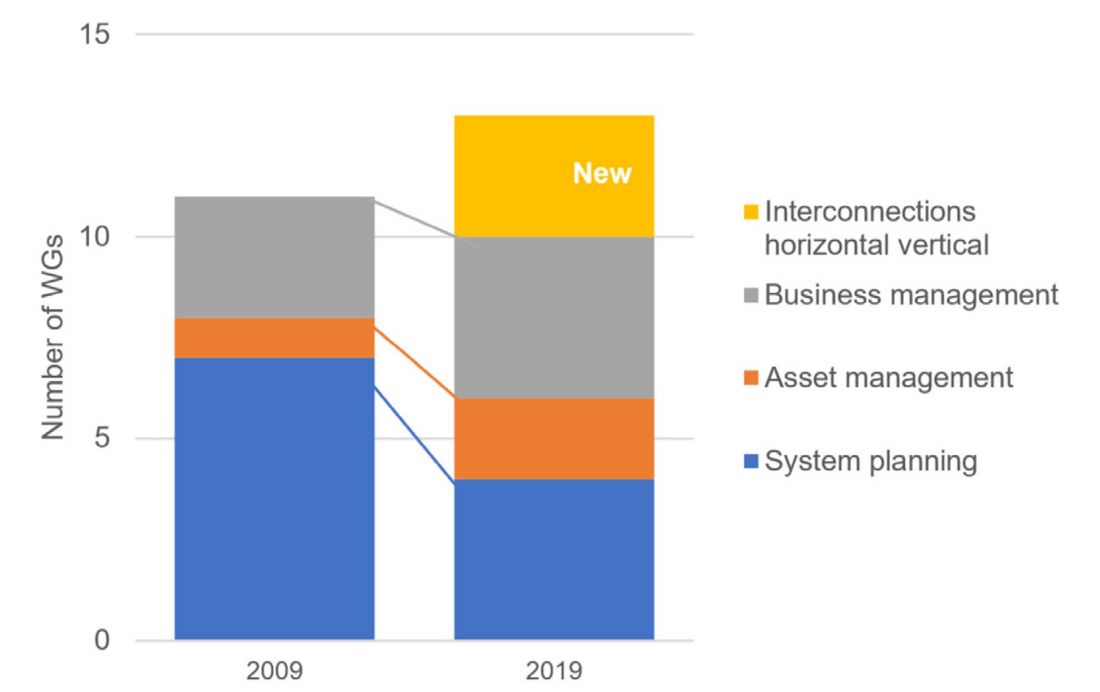
Figure 9 - SC C1 evolution
SC C2 - Power system operation and control
SC C2 works with three SD, namely, Real-time System Operation and Control, System Operational Planning and Performance Analysis and Control Centre Infrastructure and Human Resources for System Operation.
The new aspects being addressed more recently at each SD are described below:
- SD 1: Real-time System Operation and Control: Increased coordination, PMU based Wide Area Control, Operation and control of new technologies, observability, controllability and flexibility (new ancillary services and congestion management schemes)
- SD 2: System Operational Planning and Performance Analysis: Impact on system operations from new generation mix, Impact assessment on integration of new technologies, Restoration in evolving environment & Operational Resilience, Harmonisation and preparation of operational requirements in new grid codes
- SD 3: Control Centre Infrastructure and Human Resources for System Operation: Connection with cyber security and vulnerability aspects in Control Centres, WAMS system requirements and their integration within control centres, New tools for decision support and situational awareness.
Figure 10 describes the evolution on SC C2.
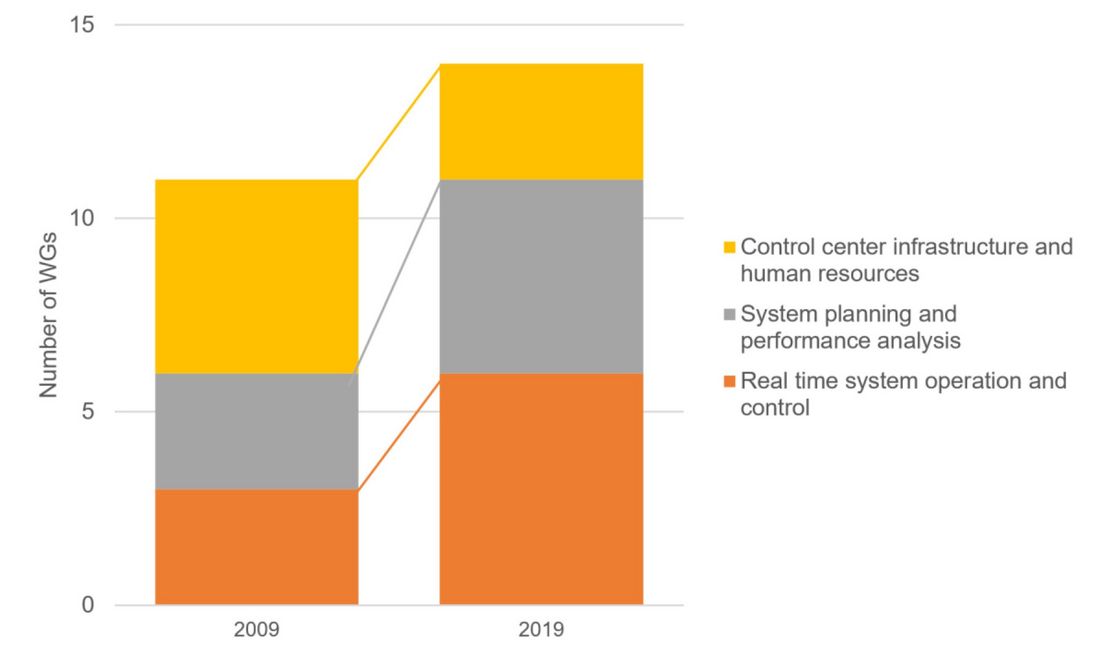
Figure 10 - SC C2 evolution
SC C3 - Power system environmental performance
SC C3 previously worked with four SD, as described below:
- SD 1: Efficiency in electrical system, which now became Asset management and environment
- SD 2: Environmental Global Changes, which now became Sustainability role of the power sector
- SD 3: Public acceptance, which now became Stakeholders engagement & public acceptance
- SD 4: Efficiency in electrical system has been closed
Figure 11 summarizes the evolution of SC C3.
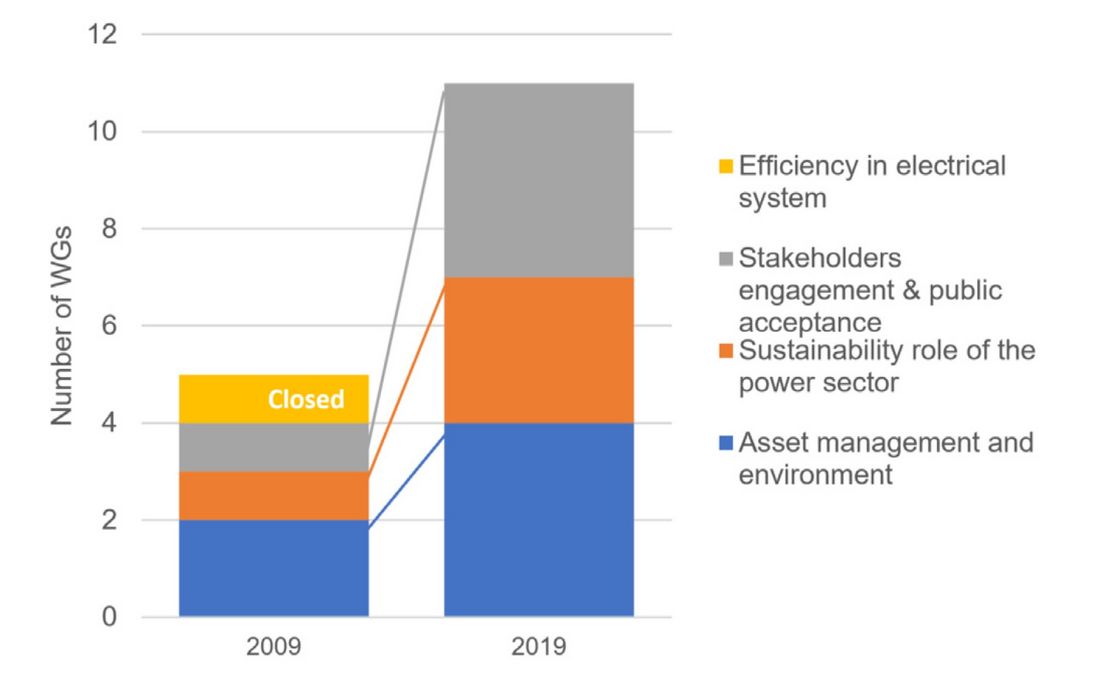
Figure 11 - SC C3 evolution
SC C4 - Power system technical performance
The main technical directions in SC C4 are:
- SD 1: Power Quality dealing with the continuity of the end-to-end electric power supply and voltage waveform quality.
- SD 2: Electromagnetic Compatibility and Interference (EMC/EMI) dealing with high frequency disturbances on the end to end electricity supply and all disturbances reaching equipment other than through the electricity supply.
- SD 3: Insulation Co‐ordination dealing with methods and tools of insulation coordination and electromagnetic transient analysis.
- SD 4: Lightning dealing with analysis of lightning characteristics and interactions with electric power systems and equipment.
- SD 5: Power Systems Dynamics and Numerical Analysis dealing with development of advanced tools, new analytical techniques for assessment of power system dynamic/transient performance, security, design of controls and modelling of existing and new equipment.
Main shifts observed in C4 can be summarized as in two parts: in power system dynamics and numerical analysis due to increased need of new analytical techniques associated with increased power electronic based technologies, and secondly in the EMC where new technologies such as wind and solar generation EMC concepts are investigated.
Figure 12 summarizes the evolution of SC C4.
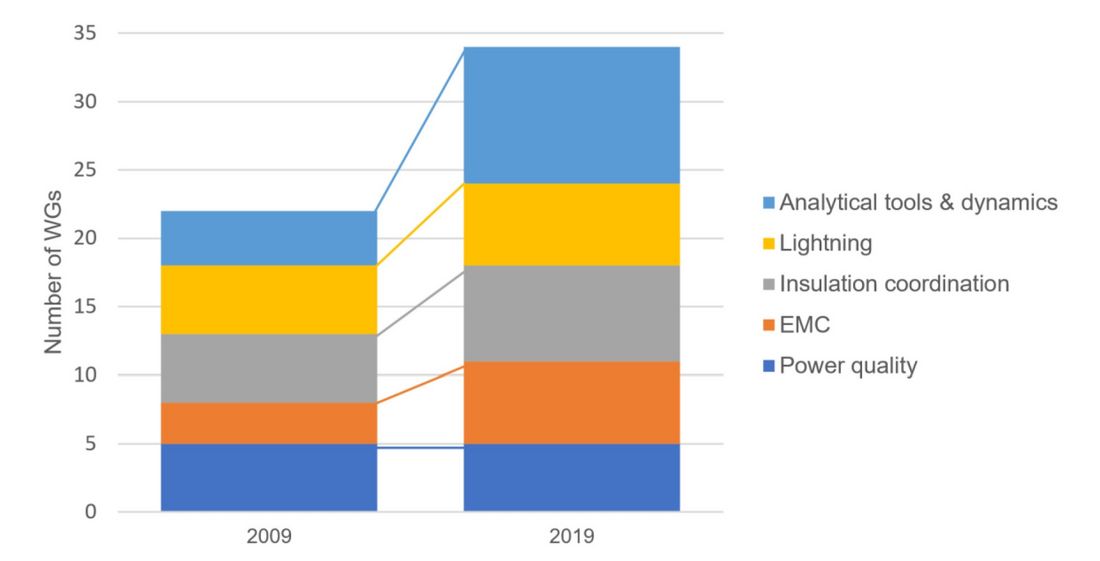
Figure 12 - SC C4 evolution
SC C5 - Electricity markets and regulation
The five main technical directions in SC C5 are:
- SD 1: Wholesale market
- SD 2: Market Integration
- SD 3: Retail Market
- SD 4: previously Wholesale investment, closed and replaced by Edge of Grid
- SD 5: New technologies
Figure 13 summarizes the evolution of SC C5.

Figure 13 - SC C5 evolution
SC C6 - Active distribution systems and distributed energy resources
SC C6 worked previously with three main SD and included a new one as SD2.
To take all relevant new developments of active distribution systems and distributed energy resources into account the technical directions of SC C6 evolved, from 2014 to 2019, as indicated in Figure 14 to:
- SD 1: Enabling technologies for renewable and distributed energy resource integration and application
- SD 2: Innovative solutions for DER and distribution technology deployment
- SD 3: New approaches to configure, plan and operate new distribution systems for enhanced reliability and resilience
- SD 4: Rural Electrification
Figure 14 summarizes the evolution of SC C6.
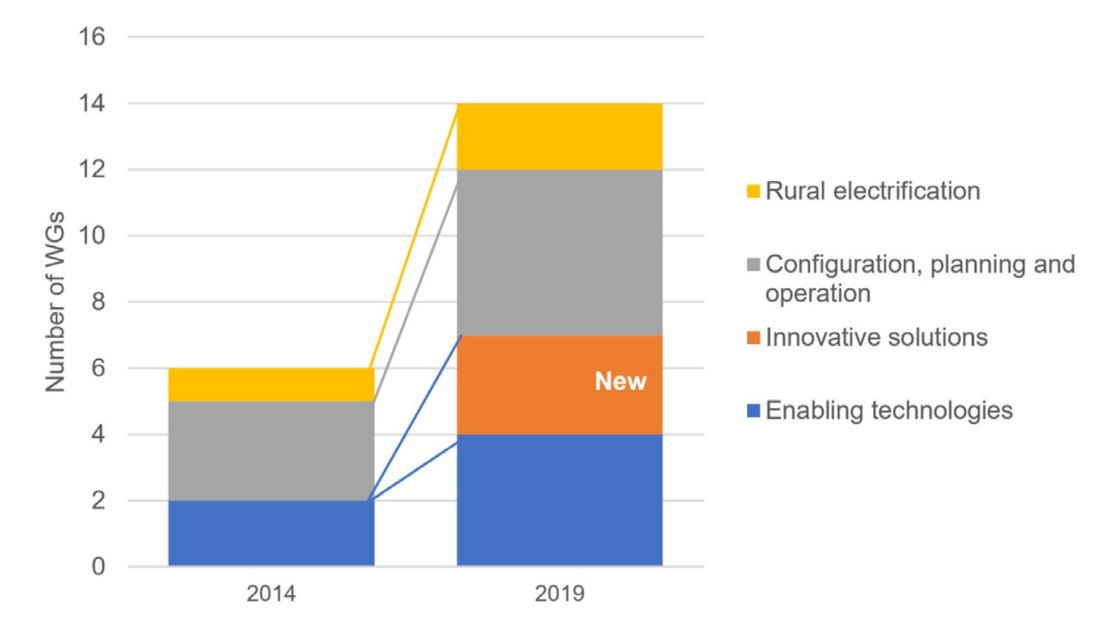
Figure 14 - SC C6 evolution
Study Committees D
SC D1 - Materials and emerging test techniques
The five main technical directions in SC B5, which comprise, equipment such as Capacitors, Transformers, Cables and GIS systems are:
- SD 1: Solid
- SD 2: Gases
- SD 3: Liquids
- SD 4: Diagnosis
- SD 5: Testing
One new trend verified in this SC is the greater emphasis to dealing with DC equipment.
Figure 15 summarizes the evolution of SC D1.

Figure 15 - SC D1 evolution
SC D2 - Information systems and telecommunication
SC D2 has been working on five SD as follows:
- SD 1: Telecom network technologies and management
- SD 2: Implementation of the networks of the future
- SD 3: New digital trends used by EPU and new business services
- SD 4: Cyber Security
Initially the main directions of SC D2 scope were focused on physical infrastructure development for large electric systems and Core Telecom network technologies.
Currently according to CIGRE 3D strategy of development (Decarbonization, Decentralization, DER) D2 Technical directions are extended and include technologies related to the interconnection of new flexibility providers: Renewable Energy Sources operators, flexible prosumers, microgrid operators, aggregators, as well a great care into the issue of Cybersecurity.
Figure 16 summarizes the evolution of SC D2.
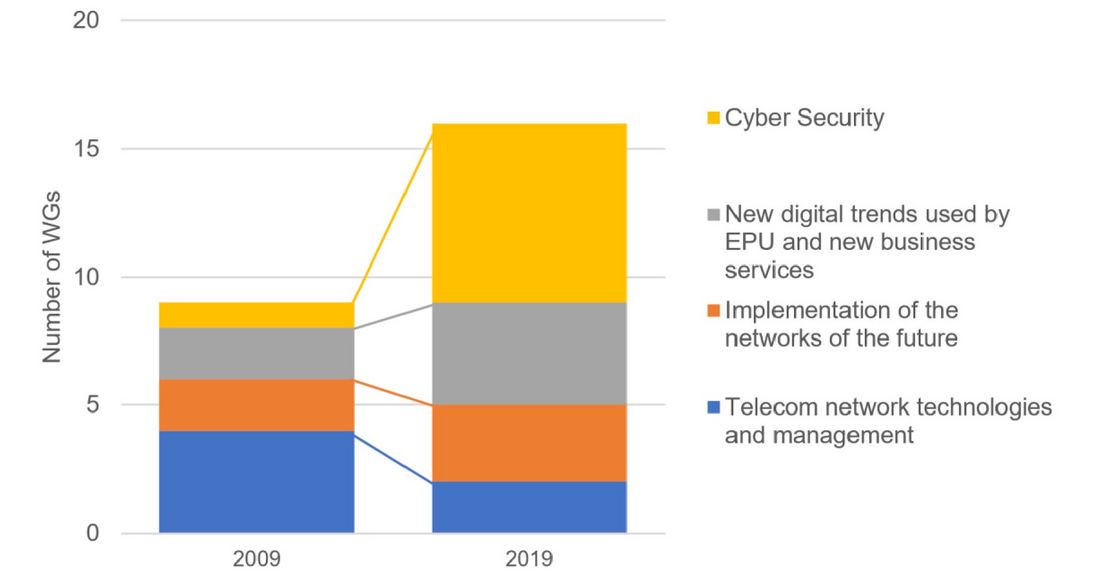
Figure 16 - SC D2 evolution
Conclusions
From the reports above, it becomes clear the growth of the organization and, also, the extreme care taken by all Study Committees to deal with state-of-the-art issues.
Thumbnail & Banner credit : Photo by Alex Rodríguez Santibáñez on Unsplash





